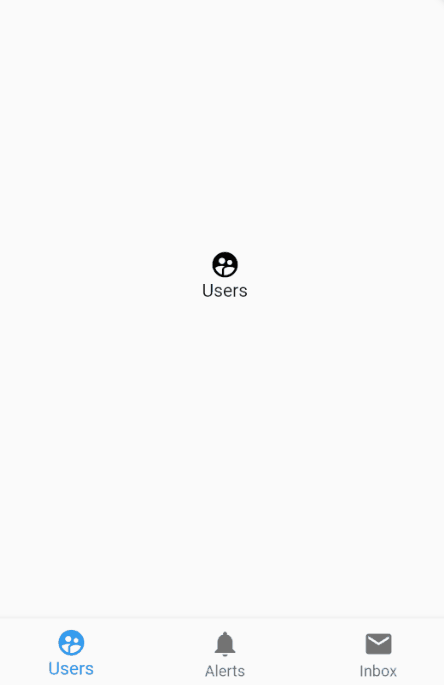I am using a BottomNavigationBar together with a TabController. By clicking on the different Tabs of the BottomNavigationBar the TabView is changing the content. However if I swipe on the TabView to switch to another view/tab the BottomNavigationBar is not updating to the tab I swiped to. I already have added a listener to the TabController to detect changes. But how can I update BottomNavigationBar programmatically to reflect the change?
I think it is way more elegant to use PageView instead of TabBarView specially in your case.

class BottomBarExample extends StatefulWidget {
@override
_BottomBarExampleState createState() => new _BottomBarExampleState();
}
class _BottomBarExampleState extends State<BottomBarExample> {
int _page = 0;
PageController _c;
@override
void initState(){
_c = new PageController(
initialPage: _page,
);
super.initState();
}
@override
Widget build(BuildContext context) {
return new Scaffold(
bottomNavigationBar: new BottomNavigationBar(
currentIndex: _page,
onTap: (index){
this._c.animateToPage(index,duration: const Duration(milliseconds: 500),curve: Curves.easeInOut);
},
items: <BottomNavigationBarItem>[
new BottomNavigationBarItem(icon: new Icon(Icons.supervised_user_circle), title: new Text("Users")),
new BottomNavigationBarItem(icon: new Icon(Icons.notifications), title: new Text("Alerts")),
new BottomNavigationBarItem(icon: new Icon(Icons.email), title: new Text("Inbox")),
],
),
body: new PageView(
controller: _c,
onPageChanged: (newPage){
setState((){
this._page=newPage;
});
},
children: <Widget>[
new Center(
child: new Column(
mainAxisAlignment: MainAxisAlignment.center,
children: <Widget>[
new Icon(Icons.supervised_user_circle),
new Text("Users")
],
),
),
new Center(
child: new Column(
mainAxisAlignment: MainAxisAlignment.center,
children: <Widget>[
new Icon(Icons.notifications),
new Text("Alerts")
],
),
),
new Center(
child: new Column(
mainAxisAlignment: MainAxisAlignment.center,
children: <Widget>[
new Icon(Icons.mail),
new Text("Inbox")
],
),
),
],
),
);
}
}
Full answer are here :https://stackoverflow.com/a/63258130/10563627
First make a class MyBottomBarDemo
class MyBottomBarDemo extends StatefulWidget {
@override
_MyBottomBarDemoState createState() => new _MyBottomBarDemoState();
}
class _MyBottomBarDemoState extends State<MyBottomBarDemo> {
int _pageIndex = 0;
PageController _pageController;
List<Widget> tabPages = [
Screen1(),
Screen2(),
Screen3(),
];
@override
void initState(){
super.initState();
_pageController = PageController(initialPage: _pageIndex);
}
@override
void dispose() {
_pageController.dispose();
super.dispose();
}
@override
Widget build(BuildContext context) {
return Scaffold(
appBar: AppBar(
title: Text("BottomNavigationBar", style: TextStyle(color: Colors.white)),
backgroundColor: Colors.deepPurple,
),
bottomNavigationBar: BottomNavigationBar(
currentIndex: _pageIndex,
onTap: onTabTapped,
backgroundColor: Colors.white,
items: <BottomNavigationBarItem>[
BottomNavigationBarItem( icon: Icon(Icons.home), title: Text("Home")),
BottomNavigationBarItem(icon: Icon(Icons.mail), title: Text("Messages")),
BottomNavigationBarItem(icon: Icon(Icons.person), title: Text("Profile")),
],
),
body: PageView(
children: tabPages,
onPageChanged: onPageChanged,
controller: _pageController,
),
);
}
void onPageChanged(int page) {
setState(() {
this._pageIndex = page;
});
}
void onTabTapped(int index) {
this._pageController.animateToPage(index,duration: const Duration(milliseconds: 500),curve: Curves.easeInOut);
}
}
Then create a your screens
class Screen1 extends StatelessWidget {
@override
Widget build(BuildContext context) {
return Container(
color: Colors.green,
child: Center(child: Text("Screen 1")),
);
}
}
screen 2... Screen 3...

If you love us? You can donate to us via Paypal or buy me a coffee so we can maintain and grow! Thank you!
Donate Us With